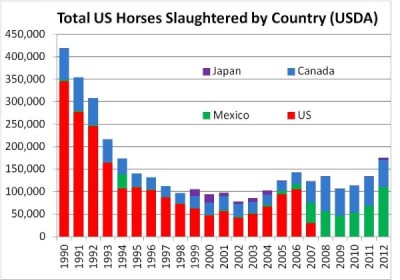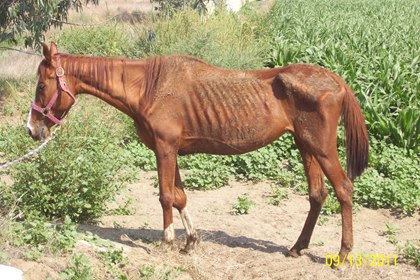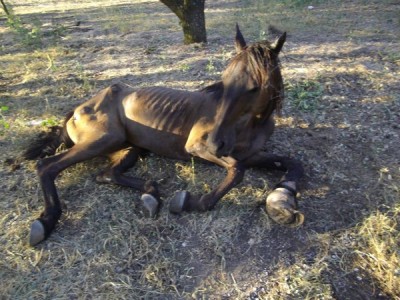History of the Horse – Part 10
|
|
Geschichte des Pferdes – Teil 10
|
Our times 10:
- We have now looked at the significance of the relationship between horses and humans over the last Blogs – how it is or how it could be. In another series I stated what it should be in my opinion – but mostly isn’t. Here many ugly things have reared their heads.
- After we admired in the last Blog the majestic abodes, where the most expensive of horse royalty are being reared, we now unfortunately also have to look at some statistics of the less fortunate – the neglected horses, which form a sad part of our present horse history.
- We “horse-lovers” should not close our eyes to those facts, but keep ourselves informed and help to save them, wherever we can. Horses are so pitifully at our mercy!
|
|
Unser Zeitalter 10:
- Wir haben nun über viele Blog hinweg angeschaut, welches Verhältnis Menschen zu Pferden haben – oder haben können. In anderen Serien habe ich gesagt, was für ein Verhältnis wir meiner Ansicht nach haben sollten! Das ist aber meistens nicht der Fall – es sind hier doch sehr viele häßliche Dinge ans Licht gekommen.
- Nachdem wir im letzten Blog die herrschaftlichen Gestüte bewundert haben, wo die Teuersten der Teuren gezüchtet werden, müssen wir nun leider noch die Statisiken der weniger Glücklichen erwähnen – die vernachlässigten Pferde, die einen traurigen Bestandteil der heutigen Pferdegeschichte darstellen.
- Wir „Pferdeliebhaber“ sollten nicht einfach die Augen zumachen, sondern auch da auf dem Laufenden sein und helfen, solche armen Tiere zu retten, wo wir nur können. Sie sind uns ja soo ausgeliefert!
|
|
|
|
|
|
|
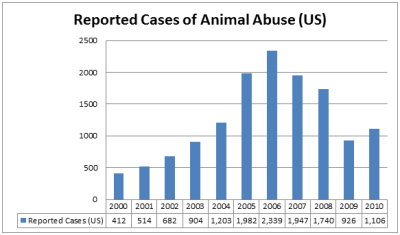
|
- Here all War Horse romantic stops – Daniel Patrick Moynihan famously said “Everyone is entitled to his own opinion, but not his own facts.”
- I suggest checking out the following websites (click and link)
- Link One
- Link TWO
- I quote JOHN HOLLAND President Equine Welfare Alliance, Inc.:
- “The factors contributing to equine abuse and neglect have long been debated, but rarely studied. It has been commonly assumed that abuse and neglect was simply an intractable and perennial problem, with little or no solution except for the disposal of excess horses through slaughter. This study finds that conventional wisdom to be completely wrong.”
|
|
- Hier hilft alle Reiterhofromantik nichts – Daniel Patrick Moynihan tat mal den berühmten Ausspruch: “Jeder kann seine eignene Meinung haben, aber nicht seine eignen Fakten”.
- Ich empfehle mal in die folgenden Websites zu schauen. (click und link)
- Link One
- Link TWO
- Ich zitiere JOHN HOLLAND President Equine Welfare Alliance, Inc.:
- “Die Faktoren, die zu Pferdemißhandlung und Vernachlässigung führen, werden schon lange debattiert, aber selten gibt es richtige Studien. Allgemein wird angenommen, daß Mißhandlung und Vernachlässigung einfach ein schwer zu verfolgendes und anhaltendes Problem sind, mit keiner richtigen Lösung als die, solche Pferde durch Schlachtung auszumerzen. Diese Studie stellt fest, daß die herkömmlichen Ansichten total falsch sind.“
|
|
|
- “Proponents of horse slaughter have long maintained that it prevents abuse and neglect. If this were so, the correlation between slaughter and abuse would be a negative one.” But this is not the case. In the chart below the curves often run parallel. The total slaughter of horses increased from 2008 to 2012 by about 80,000 from 100,000 to 180,000 in the US alone. For Europe it is hard to find similar statistics.
|
|
- “Befürworter der Schlachtung haben lange behauptet, daß sie Mißhandlung und Vernachlässigung verhindern würde. Wäre das so, dann wäre die Wechselbeziehung negativ.“ Das ist aber nicht der Fall. In der unten bezeigten Graphik laufen die Kurven oft parallel. Die Summe der Schlachtungen in den USA stieg von 2008 bis 2012 um 80.000 – von 100.000 auf 180.000. Für Europa sind solche Statistiken schwer zu finden.
|
|
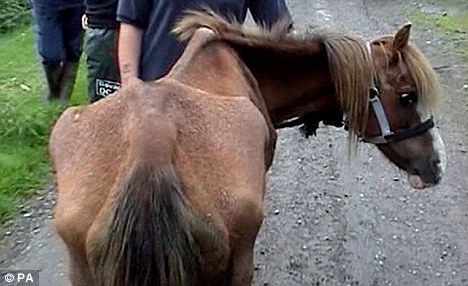
|
- Several states across the US brought in legislation to curb slaughter, but this only shifted the statistics : “In 2007, the three remaining horse slaughter plants in the US were shut down after a series of state legislative and legal actions. There was only a slight dip in horse slaughter as the plants immediately moved operations over the borders into Canada and Mexico. These closures had no real impact on the total number of horses being slaughtered.”The analysis found more slaughter consistently correlated with more abuse and neglect. “Correlation is not proof of causation,” said Holland, “but it certainly contradicts the theory that slaughter decreases neglect by culling ‘unwanted horses’.”
The conclusions from the currently available data in the study about neglect by John Holland are:
- The most important factor by far is the cost of hay
- Slaughter is the second most important correlation to abuse and neglect
- Unemployment is the least significant contributor.
|
|
Mehrere Staaten in den USA haben Gesetze verabschiedet, welche die Pferdeschlachtung eingrenzen sollten, was aber nur die Statistiken verschoben hat : „2007 wurden die letzten drei Pferdeschlachthöfe nach einer Reihe von Prozessen geschlossen. Das resultierte aber nur in einem leichten Gefälle der Schlachtzahlen, da das Geschäft sofort nach Kanada und Mexico verlagert wurde. Die Schließung hatte daher keine richtige Auswirkung auf die Summe der geschlachteten Pferde.“
Die Analyse zeigte, daß vermehrte Schlachtung immer in Übereinstimmung mit vermehrter Vernachlässigung und Mißhandlung einhergeht. „Diese Entsprechung ist kein Beweis für die Verursachung“ sagt Holland, „aber es widerspricht auf jeden Fall der Theorie, daß Schlachtung durch Eliminierung der unerwünschten Pferde eine Verminderung der Vernachlässigung mit sich bringt.“
Das Ergebnis der z.Z. verfügbaren Daten in Hollands Studie über Vernachlässigung ist:
- Der wichtigste Faktor ist ist bei weitem der Heupreis
- Schlachtung ist die zweitwichtigste Wechselbeziehung zur Vernachlässigung
- Arbeitslosigkeit steuert am wenigsten dazu bei.
|
|
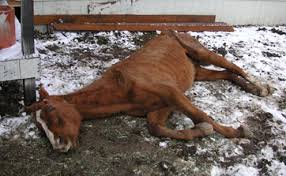
|
- The “ observation is that hay prices (in the US) show some remarkable similarities to the abuse curves, with every state showing a peak in 2008 and a general increase from 2010 through 2012. It is also unusual to see the operational costs for any industry exhibit this level of inflation.”
- Therefore the biggest pressure on horse owners is the severe increases in the price of feed. These prices have been driven by long-term land use changes and by the short-term impact of weather.
- Land-use, the on-going urbanization of so many formerly agricultural areas, considerably decreases the hay and alfalfa crop, which, combined with government promoted export of these commodities, reduces the amount of available hay precipitously (in the US). (Figure 22, page 26 of the above study, which I can’t reproduce here, shows this clearly). As droughts then occurred from the Southeast to the Western states in the US, they had a devastating effect on the already struggling horse owners.
- The thing that the film War Horse brought home is the bravery and the suffering that horses went through with us in war. It’s easy to think that today we’ve moved on and that we treat animals more favourably, since horses have gone from being very much work animals to leisure animals.
|
|
- Es gibt die „Beobachtung, daß Kurven (in den USA) der Heupreise erstaunliche Ähnlichkeit mit denen der Mißhandlung aufzeigen, mit einem Höchststand 2008 und einem generellen Anstieg von 2010 bis 2012. Es ist auch ungewöhnlich zu sehen, daß die Betriebskosten irgendeiner Industrie solch ein Niveau der Inflation zeigen.“
- Der größte Druck auf Pferdebesitzer ist also der scharfe Anstieg der Futterpreise. Diese Preise werden von den langfristigen Veränderungen der Bodennutzung und den kurzfristigen des Wetters in die Höhe getrieben.
- Bodennutzung, die ständige Verstädterung so vieler ehemals landwirtschaftlicher Gegenden, hat die Produktion von Heu und Luzerne drastisch vermindert, und, kombiniert mit von der Regierung geförderten steigenden Ausfuhrtendenzen (in den USA) hat das verfügbare Futter scharf reduziert. (Fig. 22, auf Seite 26 der oben genannten Studie, die ich hier leider nicht reproduzieren kann, zeigt das deutlich). Als dann noch Dürren in den südöstlichen und westlichen Staaten der USA dazukamen, hatte das einen verheerenden Effekt aud die eh schon belasteten Pferdebesitzer.
- Der Film „War Horse“ hat den Menschen die Tapferkeit und die Leiden der Pferde gezeigt, die mit uns den Krieg durchgemacht haben. Man denkt nun leicht, daß das hinter uns liegt und wir den Pferden wohlgesinnt sind, da die meisten nun von Arbeitstieren zu Freizeitkumpanen geworden sind.
|
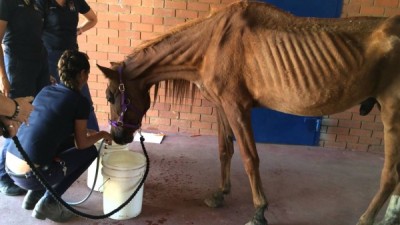 Tied up and helpless … and abandoned by his owners.
Angebunden und hilflos – von seinem Besitzer verlassen.
|
- Unfortunately, that hasn’t necessarily meant their lot has improved on the whole, and the big problem that we face today is the over-production of horses.
Over-production of horses:
- Breeding statistics for race horses are easy to get from the Internet, but for the back-yard-bred ones are hard to find, as nobody really keeps track. This report from the UK gives a good insight:
|
|
- Leider hat das nicht unbedingt bedeutet, daß sich ihr Los im Ganzen verbessert hat – und das große Problem von heute ist eine Überproduktion von Pferden.
Überproduktion:
- Zuchtstatistiken von Rennpferden sind leicht im Internet nachzuschauen, aber für die hinter-dem-Haus gezüchteten Pferde sind sie schwer nachzuweisen, da niemand es verfolgt. Der folgende Bericht aus England zeigt die Probleme auf:
|
|
|
- “Redwings – Britain’s biggest charity for abandoned horses – says the situation has reached breaking point. It has seen the number of cases soar from 160 horses in 2009 to 450 last year. So far this month it has taken in up to 10 a day. The charity, which can house 1,200 animals, is now full.
- The national situation is hard to quantify, but the RSPCA is aware that at least 3,500 horses are left chained or tied up without shelter at any one time. The charity estimates it received more than 7,000 calls in 2011 reporting horses and ponies that had been left tied up – up 21 per cent on the previous year. The Blue Cross animal charity estimates the average cost of keeping a horse has almost doubled in the past five years, from £3,600 per year to £6,000. Many animals do not get that far: increasingly, new-born foals are being killed, particularly mares which are unlikely to raise any money.
- Many more horses are being sold for meat. Zoos are among those that benefit: a single tiger can get through 15kg of meat a day. Government figures reveal that almost 8,000 horses were slaughtered for meat in 2010 – a 50 per cent increase on previous years. A combination of rising costs of essentials like hay and straw, along with a drop in the value of the animals, has created a vicious circle in which horses suffer, according to campaigners. Even charities such as the Blue Cross, which get discounts for bulk buying, have seen a massive jump in costs in the past year – the price of a bale of hay has risen from £2.50 to £4 in some areas.Andrew Elliott, an auctioneer at …one of the largest horse dealers in Europe, said: “For the very best horses, the cream of the crop, prices have pretty much held up, but in the middle and lower ranks prices have collapsed. … They get treated like something that’s worth £5, to be honest. They get bought by people who think they’ll be able to make a few quid on them, which they won’t and, because they are essentially worthless, they get treated like they are worthless – and that’s the sad reality.”
|
|
- „ Redwings – Englands größte Wohltätigkeits-einrichtung für verlassene Pferde – steht kurz vor dem Zusammenbruch. Die Anzahl der zu rettenden Pferde ist von 2009 mit 160 Tieren auf 450 Pferde im letzten Jahr angestiegen. Diesen Monat allein haben sie bis zu 10 Pferde pro Tag angenommen. Die Einrichtung, die 1.200 Tiere unterbringen kann, ist jetzt voll.
- Landesweit ist die Situation schwer zu erfassen, aber die RSPCA ermittelte, daß zu jedem Zeitpunkt mindestens 3 500 Pferde ohne Unterstand angebunden verlassen werden. Die Institution schätzt, daß sie 2011 über 7000 Anrufe über im Stich gelassene Pferde und Ponies erhalten hat – 21 % mehr als im Vorjahr. Die Blue Cross Animal Charity schätzt, daß die durchschnittlichen Pferdehaltungskosten sich in den letzten 5 Jahren fast verdoppelt haben (von £3,600 pro Jahr auf £6,000).
- Viele Tiere machen es nicht mal so lange: immer öfter werden schon neugeborene Fohlen getötet, vor allem Stutfohlen, die noch weniger Geld einbringen. Noch mehr Pferde werden für Fleisch verkauft. Zoos profitieren hiervon: ein einziger Tiger frißt bis zu 15 kg Fleisch pro Tag. Statistiken der Regierung zeigen, daß fast 8 000 Pferde im Jahr 2010 für Fleisch geschlachtet wurden – ein Anstieg von 50 % gegenüber den vorigen Jahren. Die Kombination des Preisanstiegs von grundlegenden Dingen wie Heu und Stroh mit einem gleichzeitigen Abfall der Preise für Pferde, hat einen Teufelskreis geschaffen, in dem die Tiere leiden. Sogar Wohltätigkeitseinrichtungen wie das Blue Cross, die Rabatt für Großeinkaufspreise erhalten, haben einen scharfen Kostenanstieg verzeichnet – für einen Heuballen sind die Preise in einigen Gegenden von £2.50 auf £4 angestiegen. Andrew Elliott, ein Auktionär … einer der größten Pferdehändler in Europa, sagt: „Für die besten Pferde, die wahre Sahne, sind die Preise ziemlich gleich geblieben, aber in den mittleren und unteren Rängen sind sie zusammen gebrochen… die Pferde werden wirklich behandelt wie etwas, das nur £5 wert ist. Sie werden gekauft von Leuten, die denken, sie könnten schnell ein paar Pfund verdienen, was dann nicht der Fall ist, und, da die Pferde dann eigentlich wertlos sind, werden sie auch so behandelt – das ist die traurige Realität.“
|
|
| Oh those “human” human beings!! Another depressing Blog!
Read on anyhow… |
|
Ach ja, die Menschen!! Wieder ein deprimierender Blog!
Lesen Sie dennoch weiter … |

